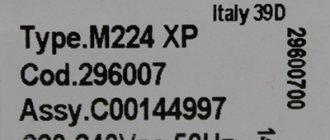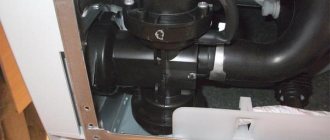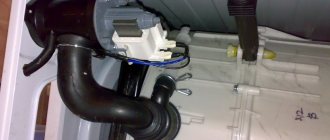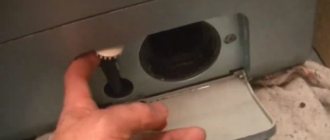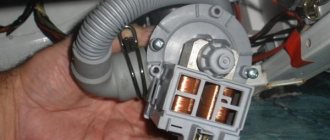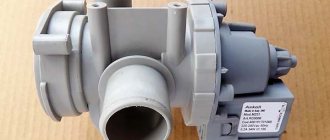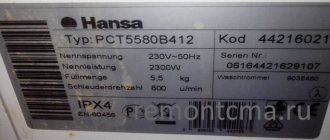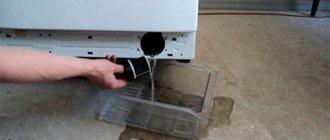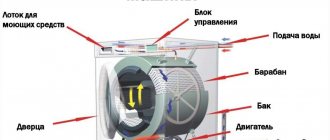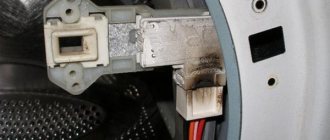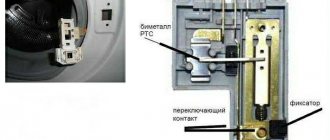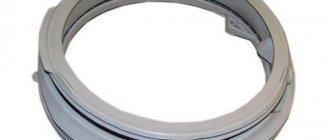An automatic washing machine is now found in almost every modern home. This irreplaceable assistant works tirelessly for years, but sooner or later, like any other equipment, it begins to fail. If problems arise at the stage of pumping or draining water, most likely the drain pump has become unusable. It is this that ensures the normal operation of the entire device. The pump for a washing machine is one of the main technical components, which is directly involved in every stage of washing.
Types of pumps in a washing machine
Washing machine repair specialists claim that the original factory pump, subject to normal operation, lasts on average at least 10 years. Premature problems can arise due to lack of proper and timely care of the part, as well as simple clogging with small metal debris and various technical impurities in the water.
In some cases, the pump can be repaired, but sometimes it has to be replaced completely. Then the question arises of choosing a suitable pump. It should be approached with all responsibility, since the complexity of the installation and further operation of the equipment depend on it.
There are more than 50 types of pumps in automatic washing machines. For convenience, they can all be divided into two main types:
- drain - used in budget or outdated versions of machines. A simple mechanism drains water into the drain after each wash cycle;
- circulating - they supply water to the washing zone and circulate it along a closed path in only one direction. Most often, they work in tandem with a conventional pump to increase efficiency. This significantly improves washing efficiency.
A more detailed classification is considered in accordance with the following characteristics:
- fastening method - there are options with latches, screws, and combined, when the previous two types are combined;
- according to the characteristics of the contact connections - there are pumps with terminals that go in the opposite direction from the impeller, behind it and “under the chip”. In the latter version, the connector has a rectangular shape, and the connections are parallel to each other;
- power - the average value ranges from 15 to 100 W. If there is insufficient power, the device is not able to perform the job fully. Most models have a power of 34-40 W. In old units, high-power pumps were very large and costly to manufacture, but modern pumps with higher power are distinguished by their completely small sizes;
- number of branches - standard or branched. The latter is a kind of tee, one outlet is directed to the sewer, the other to the sink, and the third is connected to the washing machine. For residents of multi-storey buildings, a siphon with a check valve is considered a good option. It blocks the return of liquid to the machine if the drain hose is clogged;
- shape and size - more modern varieties are compact and well thought out. They take up very little space while maintaining excellent functionality. For example, the now popular powerful synchronous pumps with a magnetic rotor are very small in size.
The question of the manufacturer remains no less important. The highest quality and most modern pumps are produced by Italian brands Askoll and Plaset. Their products are used in more than half of all washing machines produced in the world. Besides these, Mainox, Hanning, Artiko and CopreciGre are also well known.
Undoubtedly, it is best to give preference in choosing a complete analogue of the original pump. It will fully comply with the technical parameters of the device and will not cause additional problems when connecting. It will be enough to simply restore all connections as they were before the intervention.
Drain pump device
The drain pump for a washing machine has the following technical characteristics:
- power consumption - usually from 25 to 40 W;
- type of fastening to the volute - screw or fastening with latches;
- contact arrangement - paired or separate;
ATTENTION! When choosing a new pump, be sure to pay attention to the type and technical characteristics of the old pump, since the new one may not be suitable for some of the above parameters.
The pump in the washing machine differs not only in appearance, but also in the type of “snail” filter installed inside them. Very often the filter becomes clogged, and in this case the water is not completely drained from the chamber, then the dirty liquid stagnates and an unpleasant odor appears inside the drainage system. In this case, it is necessary to check the condition of the filter. You will need some tools, since the device cannot be removed with bare hands. The filter can be cleaned and the problem may be resolved.
The internal structure looks something like this:
The pump rotor is a permanent magnet in the form of a cylinder, which is located in a plastic casing. When the system starts up, the rotor first turns on, then the impeller, located on the shaft at an angle of 180 degrees, begins to move. The impeller relative to the armature should have a small stroke; this is necessary for normal engine starting, since there is a load due to water.
The rod, or otherwise the magnetic core, has two insulating windings that are connected to each other. The whole design is similar to an asynchronous motor, where there is also a moving and a stationary part. The moving part is a rotor in the form of a cylinder, and the stationary part is a magnetic core with windings.
This is how a simple washing machine pump works.
For example, if the impeller of the impeller falls off from the pump, this will inevitably lead to the need to replace the pump, since it cannot be repaired.
The washing machine's circular pump only allows liquid to flow in one direction.
For example, in the pump of a Samsung washing machine, a sealing collar is used to block the independent entry of liquid. This is necessary to prevent water from leaking into the bearing. Also, such mechanisms are equipped with a rotor shaft, which passes through a central collar bushing, which is crimped in the form of a spring ring.
Before the cuff is secured in the desired bushing, it must be lubricated with a special technical lubricant. The product is applied in a thick layer so that when starting work it gets into all the necessary gaps. This action has a positive effect on the operation of the mechanism and significantly increases its service life.
Signs of a faulty drain pump
You can distinguish a drain pump breakdown from other types of malfunction by the following main characteristics:
- During normal operation of the washing machine, water is pumped out very slowly.
- Lack of response to programs.
- Small volume of water in the machine tank.
- The device makes a lot of noise or crackles when pumping or draining water.
- The pump makes a loud noise, but no water comes out at all.
- During the draining process, the pump automatically turns off.
If at least one of the above symptoms is present, it is necessary to urgently diagnose the drain pump. It may be necessary to simply clean the clogged parts, and the operation will be completely restored.
Also, the occurrence of a breakdown is reported by service codes, which can be deciphered on the manufacturer’s website or in the accompanying instructions.
In order to correct the breakdown, it is necessary to inspect the drain pump and figure out what exactly led to the occurrence of this malfunction. The options may be the following:
- clogging of the drain system: filter, pump or pipe;
- clogged sewer system;
- no voltage on the pump - occurs when the engine malfunctions or other defects in the supply of electrical contacts occur;
- damage to the rubber or plastic seal - occurs as a result of the accumulation of dirt and scale on the impeller of the device;
- destruction of the impeller - accompanied by extraneous sounds when the wash starts;
- short circuit or break in the winding;
- the motor bushings are worn out;
- the pump runs continuously - occurs as a result of incorrect connection or malfunction of the water level sensor.
The principle of operation of the washing machine
In modern automatic washing machines, water flows by gravity, that is, under water pressure from the tap to which the equipment is connected. Based on the software settings selected at the user’s discretion, the magnetic valve that allows water to pass through opens to allow the required amount of liquid into the working chamber.
The water level in the washing “drum” is controlled by a special sensor called a “pressostat”.
Passing through the detergent containers, the water mixes with them and enters the washing drum, where it remains throughout the entire washing process. When the washing is completed, the “waste” liquid flows through a special hose into the pump, which is present in the design of every automatic washing machine.
Location of the drain pump and how to get to it
A broken washing machine can be sent to a service center for diagnosis and repair, but if you wish, you can deal with the problem on your own. Depending on the distinctive features of the model, the pump may be located in different places of the machine. General instructions in this situation recommend the following sequence of actions:
- De-energize the washing machine by unplugging it from the outlet.
- Shut off the water supply.
- Turn the device over so that the drain is on top.
- Unscrew and remove the top cover. Typically, the drain filter unwinds several turns.
- Place a container prepared in advance for the remaining water.
- Clean the filter mesh from accumulated debris.
After performing these simple manipulations, it becomes possible to examine in detail the internal mechanism of the equipment, since all the parts are located at the bottom of the device. For convenience, it is better to illuminate with a flashlight. If necessary, the impeller should be cleared of debris and try to carefully rotate it by hand - ideally, it should rotate with slight delays.
The easiest to inspect machines are those manufactured by Electrolux, Samsung, Candy, LG and Zanussi. Typically, their diagnosis is carried out through the bottom or by removing the rear panel. But Indesit, Siemens and Bosch lose in this matter - all the most important parts are located under the front cover of the machine. In such cases, you first need to remove the loading hatch, which is a rather lengthy and labor-intensive process.
Where is the pump located
Models of washing machines Candy, LG, Whirpool, Ariston, Beko, Samsung are equipped with a pump located at the bottom. To get to it, the washing machine is laid on its side and the bottom panel is removed. The snail with the filter is attached with screws that can be unscrewed and the required part is in your hands.
If we talk about Zanussi and Electrolux models, their pump is located behind the back cover, which will need to be removed.
The most difficult models to disassemble are Bosch, AEG, Siemens. They will have to dismantle the entire front panel.
Where is the pump located
To remove the pumping system from the body of an automatic washing machine (WMA), there are different methods, depending on the model of the unit. Models from Whirpool, Samsung, Ariston, Beko, LG, and others do not have a bottom. Accordingly, you can remove the pump by tilting or laying the device on its side and disconnecting the bottom panel (open the door or hatch). After which you will see the screws that secure the volute with filter to the front plate.
Everything is very simple in SMA Electrolux and Zanussi. Just open the back cover of the machine and you will see the required unit that needs to be disassembled. The most difficult access to the required part is in SMA AEG, Bosch and Siemens. You can get to the pump only by removing the front wall of the washing machine.
Equipment disadvantages
Like any other device, drain pumps have a number of disadvantages. These include the relatively low power of the motor, the use of which in everyday life will be extremely problematic. You should not expect a long service life from a repaired pump, and after the first breakdown, it is recommended to immediately replace such equipment. For local solutions it can be used, but only as an additional element that overheats and makes noise. After a relatively short period of time, its performance will practically be equal to 0. Further use of the repaired pumps is not recommended, therefore any subsequent manipulations will be carried out solely at your own peril and risk, without any guarantees of reliability and safety. They are able to perform only a narrow range of tasks and are unlikely to be able to jump over this threshold. Most instructions indicate that further repair and disposal are provided, but almost every craftsman tries to use all the surviving parts to produce new and serviceable equipment.
The reason is the bearings
Contamination is not the only reason for device malfunction. When the bearings fail, runout occurs during shaft rotation. Due to the beating, the impeller begins to rub against the volute casing. This causes noise and unproductive operation of the pump, up to a complete stop.
This problem can be solved by replacing ball bearings, which can be purchased at specialized retail outlets or at a household appliance service center.
If at the moment it is not possible to buy a new part, and washing cannot wait, then you can temporarily extend the life of the pump by shortening the blades by 2 millimeters with a sharp knife. But don't overdo it: if you cut more, the system's performance will drop.
After cleaning, replacing bearings or seals, the motor repair can be considered complete. Install the body with the blades into the reel and secure with latches. Subject to safety rules, connect 220 V voltage to two contacts and check the operation of the device. After making sure that the device is operating normally, you can connect the cochlea and return the entire structure to the SMA body.
As you can see, repairing a washing machine pump with your own hands is not such an impossible task and can be done by anyone who carefully reads these recommendations.
